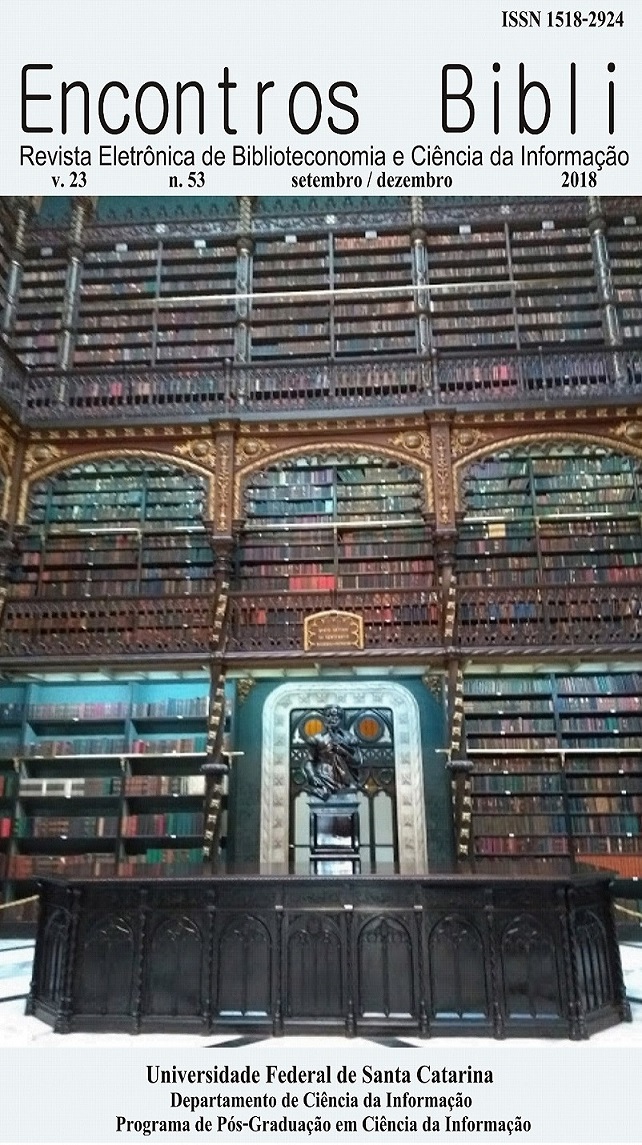Uma proposta de arquitetura de microsserviços aplicada em um sistema de CRM social
DOI:
https://doi.org/10.5007/1518-2924.2018v23n53p147Palavras-chave:
CRM Social, Web 2.0, Inteligência Competitiva, MicrosserviçosResumo
A explosão informacional, impulsionada, principalmente, pelo uso massivo de serviços da Web 2.0 é vista como um desafio para as noções tradicionais do CRM, considerando-se que o consumidor passa a ter um papel ativo no relacionamento com a empresa. Neste contexto, surge o CRM Social que é construído a partir da integração das estratégias tradicionais da Gestão de Relacionamento com o Cliente com ferramentas capazes de recuperar, armazenar e analisar informações coletadas das redes sociais. Por meio de uma pesquisa qualitativa e aplicada, este artigo busca abordar os conceitos das áreas de gestão de relacionamento com o cliente, CRM Social e Web 2.0, enumerando as características e benefícios oferecidos. Baseando-se nestas definições, propõe uma arquitetura de microsserviços para um sistema de CRM Social, que, apesar de aplicável para o enquadramento em questão, deverá ser testada com o intuito de determinar se a mesma atende aos requisitos propostos, visando performance e acurácia nas análises.
Downloads
Referências
BASTANI, Kenny. Deep Learning Sentiment Analysis for Movie Reviews using Neo4j. 2014. Disponível em: <http://www.kennybastani.com/2014/09/deep-learning-sentiment-analysis-for.html?spref=tw>. Acesso em: 04 jun. 2017.
CHEN, C.l. Philip; ZHANG, Chun-yang. Data-intensive applications, challenges, techniques and technologies: A survey on Big Data. Information Sciences, [s.l.], v. 275, p.314-347, ago. 2014. Elsevier BV. http://dx.doi.org/10.1016/j.ins.2014.01.015. Disponível em: <http://romisatriawahono.net/lecture/rm/survey/machine learning/Chen - Big Data Challenges and Techniques - 2014.pdf>. Acesso em: 16 de maio de 2017.
ENNAJI, Fatima Zohra et al. Social intelligence framework: Extracting and analyzing opinions for social CRM. In: Computer Systems and Applications (AICCSA), 2015 IEEE/ACS 12th International Conference of. IEEE, 2015. p. 1-7.
FAASE, Robbert; HELMS, Remko; SPRUIT, Marco. Web 2.0 in the CRM domain: defining social CRM. Ijecrm, [s.l.], v. 5, n. 1, p.1-21, 2011. Inderscience Publishers. Disponível em: <https://www.researchgate.net/profile/Marco_Spruit/publication/264437100_Web_20_in_the_CRM_domain_defining_social_CRM/links/565d953208ae1ef92982ef43.pdf>. Acesso em: 15 maio 2017.
FIELDING, Roy Thomas. Architectural Styles and the Design of Network-based Software Architectures. 2000. 180 f. Tese (Doutorado) - Curso de Informação e Ciência da Computação, University Of California, Irvine, 2000. Cap. 5. Disponível em: <http://www.ics.uci.edu/~fielding/pubs/dissertation/top.htm>. Acesso em: 02 jun. 2017.
GERHARDT, Tatiana Engel; SILVEIRA, Denise Tolfo. Métodos de Pesquisa. Porto Alegre: Ufrgs, 2009. 120 p. Disponível em: <http://www.ufrgs.br/cursopgdr/downloadsSerie/derad005.pdf>. Acesso em: 02 jun. 2017.
GLOROT, Xavier; BORDES, Antoine; BENGIO, Yoshua. Domain adaptation for large-scale sentiment classification: A deep learning approach. In: Proceedings of the 28th international conference on machine learning (ICML-11). 2011. p. 513-520.
GOPALANI, Satish; ARORA, Rohan. Comparing apache spark and map reduce with performance analysis using k-means. International Journal of Computer Applications, v. 113, n. 1, 2015.
GREENBERG, Paul. Social CRM Comes of Age. 2009. White Paper. Disponível em: <http://www.computerworlduk.com/cmsdata/whitepapers/3203130/social crm.pdf>. Acesso em: 16 de maio de 2017.
GREENBERG, Paul. The impact of CRM 2.0 on customer insight. Jnl Of Bus & Indus Marketing, [s.l.], v. 25, n. 6, p.410-419, 3 ago. 2010. Emerald. Disponível em: < http://www.academia.edu/download/32397458/1876351.pdf>. Acesso em: 16 de maio de 2017.
HUTCHINSON, Andrew. Top Social Network Demographics 2017. 2017. Elaborada por Trackx. Disponível em: <http://www.socialmediatoday.com/social-networks/top-social-network-demographics-2017-infographic>. Acesso em: 01 jun. 2017.
LEHMKUHL, Tobias; JUNG, Reinhard. Towards Social CRM: Scoping the concept and guiding research. 2013. Disponível em: <https://www.alexandria.unisg.ch/223469/1/Lehmkuhl, Jung - 2013 - Towards Social CRM - Scoping the concept and guiding research.pdf>. Acesso em: 16 maio 2017.
LIN, Melissa C. A study of main stream features of CRM system and evaluation criteria. In: Proceedings of the 2003 American Society for Engineering Education Annual Conference & Exposition. 2003. p. 1-12.
MALAVASI, Eike. API Gateway governando a arquitetura de Microservices. 2016. Disponível em: <http://sensedia.com/blog/apis/api-gateway-governando-a-arquitetura-de-microservices/>. Acesso em: 04 jun. 2017.
MALTHOUSE, Edward C. et al. Managing Customer Relationships in the Social Media Era: Introducing the Social CRM House. Journal Of Interactive Marketing, [s.l.], v. 27, n. 4, p.270-280, nov. 2013. Elsevier BV. Disponível em: < http://blog.mikezhang.com/files/socialcrm.pdf>. Acesso em: 18 maio 2017.
MAROLT, Marjeta; PUCIHAR, Andreja; ZIMMERMANN, Hans-dieter. Social CRM Adoption and its Impact on Performance Outcomes: a Literature Review. Organizacija, [s.l.], v. 48, n. 4, p.260-271, 1 jan. 2015. Disponível em: < https://www.degruyter.com/downloadpdf/j/orga.2015.48.issue-4/orga-2015-0022/orga-2015-0022.pdf >. Acesso em: 16 maio 2017.
MENG, Xiangrui et al. Mllib: Machine learning in apache spark. Journal of Machine Learning Research, v. 17, n. 34, p. 1-7, 2016.
MISHRA, Alok; MISHRA, Deepti. Customer Relationship Management: implementation process perspective. Acta Polytechnica Hungarica, v. 6, n. 4, p. 83-99, 2009. Disponível em: <http://www.scielo.br/pdf/ci/v30n1/a09v30n1>. Acesso em: 15 de maio de 2017.
MOREIRA, Pedro Felipe Marques; BEDER, Delano Medeiros. Desenvolvimento de Aplicações e Micro Serviços: Um estudo de caso. Revista TIS, v. 4, n. 3, 2015. Disponível em: < http://revistatis.dc.ufscar.br/index.php/revista/article/viewFile/364/127>. Acesso em: 04 jun. 2017.
NEWMAN, Sam. Building microservices. Sebastopol: O'reilly Media, 2015. 280 p. 1 v. Disponível em: <https://www.nginx.com/wp-content/uploads/2015/01/Building_Microservices_Nginx.pdf>. Acesso em: 04 jun. 2017.
PAYNE, Adrian; FROW, Pennie. A Strategic Framework for Customer Relationship Management. American Marketing Association, [s. L.], v. 4, n. 69, p.167-176, out. 2005. Disponível em: <http://s3.amazonaws.com/academia.edu.documents/32536185/A_strategic_framework_for_CRM.pdf?AWSAccessKeyId=AKIAIWOWYYGZ2Y53UL3A&Expires=1494962632&Signature=0GzR4npFq7LkkCPnyE4JER1kQXk=&response-content-disposition=inline; filename=A_Strategic_Framework_for_Customer_Relat.pdf>. Acesso em: 14 de maio de 2017.
POZZI, Federico Alberto et al. Challanges of Sentiment Analysis in Social Networks: An Overview. In: POZZI, Federico Alberto et al. Sentiment Analysisin Social Networks. Cambridge: Elsevier, 2017. Cap. 1. p. 11-22.
ORENGA-ROGLÁ, Sergio; CHALMETA, Ricardo. Social customer relationship management: taking advantage of Web 2.0 and Big Data technologies. Springerplus, [s.l.], v. 5, n. 1, p.1-17, 31 ago. 2016. Springer Nature. http://dx.doi.org/10.1186/s40064-016-3128-y.
RICHARDSON, Chris. Microservices: Decomposição de Aplicações para Implantação e Escalabilidade. 2014. Tradução de: Ivan Salvadori. Disponível em: <https://www.infoq.com/br/articles/microservices-intro>. Acesso em: 04 jun. 2017.
ROUSE, Margaret. Customer Relationship Management (CRM). 2014. Disponível em: <http://searchcrm.techtarget.com/definition/CRM>. Acesso em: 04 jun. 2017.
ŠEDIVÁ, Zuzana; MÜLLEROVÁ, Michaela. Social Media In Customer Relationship Management. In: 22ND INTERDISCIPLINARY INFORMATION MANAGEMENT TALKS (IDIMT) CONFERENCE, 22., 2014, Podebrady. Schriftenreihe Informatik. Podebrady: Trauner Verlag, 2014. v. 43, p. 173 - 180.
TILKOV, Stefan. Uma rápida Introdução ao REST. 2008. Tradução de: André Faria Gomes. Disponível em: <https://www.infoq.com/br/articles/rest-introduction>. Acesso em: 04 jun. 2017.
TRAINOR, Kevin J.. Relating Social Media Technologies to Performance: A Capabilities-Based Perspective. Journal Of Personal Selling And Sales Management, [s.l.], v. 32, n. 3, p.317-331, 1 jul. 2012. Informa UK Limited.
TRAINOR, Kevin J. et al. Social media technology usage and customer relationship performance: A capabilities-based examination of social CRM. Journal of Business Research, v. 67, n. 6, p. 1201-1208, 2014. Disponível em: < http://tarjomeh20.com/wp-content/uploads/2015/05/10.1016-j.jbusres.2013.05.002_df52.pdf>. Acesso em: 20 de maio de 2017.
ZABLAH, Alex; BELLENGER, Danny N.; JOHNSTON, Wesley. An evaluation of divergent perspectives on customer relationship management: Towards a common understanding of an emerging phenomenon. Industrial Marketing Management, Atlanta, v. 33, n. 6, p.475-489, 2 jul. 2004. Disponível em: <https://www.wilfridlaurier.ca/documents/12147/7.__Zablah_et_al___An_evaluation_of_divergent_perspectives.pdf>. Acesso em: 15 de maio de 2017.
Downloads
Publicado
Como Citar
Edição
Seção
Licença
Copyright (c) 2018 Luiz Felipe Correa Chiaradia, Douglas Dyllon Jeronimo Macedo, Moisés Lima Dutra

Este trabalho está licenciado sob uma licença Creative Commons Attribution 4.0 International License.
O autor deve garantir:
- que haja um consenso completo de todos os coautores em aprovar a versão final do documento e sua submissão para publicação.
- que seu trabalho é original, e se o trabalho e/ou palavras de outras pessoas foram utilizados, estas foram devidamente reconhecidas.
Plágio em todas as suas formas constituem um comportamento antiético de publicação e é inaceitável. Encontros Bibli reserva-se o direito de usar software ou quaisquer outros métodos de detecção de plágio.
Todas as submissões recebidas para avaliação na revista Encontros Bibli: revista eletrônica de biblioteconomia e ciência da informação passam por identificação de plágio e autoplágio. Plágios identificados em manuscritos durante o processo de avaliação acarretarão no arquivamento da submissão. No caso de identificação de plágio em um manuscrito publicado na revista, o Editor Chefe conduzirá uma investigação preliminar e, caso necessário, fará a retratação.
Esta revista, seguindo as recomendações do movimento de Acesso Aberto, proporciona seu conteúdo em Full Open Access. Assim os autores conservam todos seus direitos permitindo que a Encontros Bibli possa publicar seus artigos e disponibilizar pra toda a comunidade.
Os conteúdos de Encontros Bibli estão licenciados sob uma Licença Creative Commons 4.0 by.

Qualquer usuário tem direito de:
- Compartilhar — copiar, baixar, imprimir ou redistribuir o material em qualquer suporte ou formato
- Adaptar — remixar, transformar, e criar a partir do material para qualquer fim, mesmo que comercial.
De acordo com os seguintes termos:
- Atribuição — Você deve dar o crédito apropriado, prover um link para a licença e indicar se mudanças foram feitas. Você deve fazê-lo em qualquer circunstância razoável, mas de maneira alguma que sugira ao licenciante a apoiar você ou o seu uso.
- Sem restrições adicionais — Você não pode aplicar termos jurídicos ou medidas de caráter tecnológico que restrinjam legalmente outros de fazerem algo que a licença permita.

























